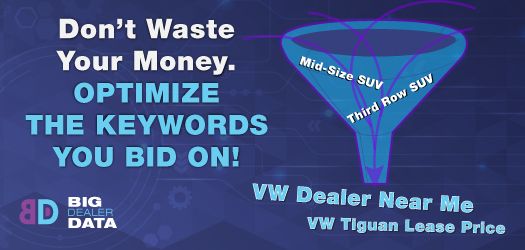KNOWLEDGEBASE
For Car Dealers Advertising Responsibly Google’s New Affinity Audiences for Search Should Be Irrelevant & Could Harm Lead Volume from OEM to Dealers
On October 14th, 2019 Google announced they would be rolling out two new targeting options for Search Campaigns – affinity audiences and seasonal event segments for in-market audiences.
While seasonal seems obviously moot, the MOST concerning area for us is in-market affinity audiences. Google cites Volkswagen specifically as benefitting from a 250% conversion rate increase.
“Volkswagen, one of the world’s largest auto manufacturers, used affinity audiences to achieve a 250% increase in conversion rate when compared to its non-audience traffic.“

As usual the concern here is context and level of specificity. Was this VW North America? Was this tier 1, tier 2 or Dealer level advertising? What keywords were they testing it with? What was the comparative improvement overall? Was this a national, state or hyper local audience?
Also, they should define what this conversion was to help users decide the true value. Was a conversion simply a user that did not bounce? What exactly increased 250%? Did they choke out traffic so much what was left was 5 people out of 20 clicks who converted to a long time on site? How many leads to dealers were lost? My hunch is with such sensationalist a claim and no data to back it up the application data is thin.
VW North America has an entirely different goal with their online marketing campaigns compared to a VW dealership. Any dealership has different goals and strategies and responsibilities as compared to an OEM. Dealers MUST live at the bottom of the funnel considering current costs per click, co-op rules which for VW dealers currently only reimburse CPO Keywords & the typical conversion state of a dealer’s website.
VW could very well see a 250% increase in conversion rates for terms such as “third row SUV” or “Mid-Size SUV” using an in-market audience such as New Volkswagen intenders. Prior to implementing the audience, they would show the ad or bid up for folks searching this term but not considering a VW. Now they can layer on in-market filtering for VW or even some close competitors such as Mazda or Subaru (the latter two I’d put in a different campaign).
What they are doing is taking a general keyword which has super generic relevance to a type of vehicle and no clear identification they would consider a VW and narrows the wheelhouse to people who are theoretically showing some level of interest to VW in particular. That makes perfect sense and in this case a MAJOR benefit to search for auto manufacturers, but NOT for dealers. At least dealers who are advertising on search responsibly. In fact, it can be argued OEMS using this feature too aggressively could be harmful to the OEMs responsibility to the dealer body. More on that in a minute.
This Should Be Irrelevant for Dealers Advertising on Search Responsibly
Let’s look at search from the dealer perspective. If your agency is buying “third row SUV” or “Mid-Size SUV” stop reading this article, open an email and fire your agency. Dealers and OEMS should stay in their lanes. A dealer’s job is to preach to pre-educated browsers expressing local interest in purchasing vehicles or service from that dealership. This is why the narrowing effect of affinity audiences are of little to no benefit to a dealer. The keywords they choose should already weed out anything else.
Consider a customer searching a term such as “VW Dealer Near Me” or “VW Tiguan Lease Price”. If a user is using a dealer word or a model word with a “kicker” such as “lease” aren’t they self-qualifying? Is there ever a time you would want to exclude anyone using this term from your targeting? The point being, Dealers should be living so low in the funnel that the user’s search should be more than enough to qualify them.
Potentially harmful to a dealership body is if their OEM over optimizes and narrows their advertising for words such as “Third Row SUV” to only their in-market brand audience. The major responsibility of the OEM is to create customers for that brand. Raise awareness to the population writ large looking for third-row SUV that their OEM has models to fulfill that need. Perhaps switching a GMC Acadia customer with fatigue to the VW Atlas. They may find that model intriguing with the car seat friendly middle row. They will read more on VW.com and perhaps find enough compelling info they decide to use the dealer locator and send a lead to that store. Or configure a car and enter a zip code also generating a lead for a dealer. In this case, over-optimization shirks the covenant between OEM and dealer.
It can help the OEM narrow that search to more relevant audiences which perhaps may work better or in concert with such demographics as income. The OEM could add several other manufacturers which directly compete weeding out irrelevant in-market OEM segments unlikely to cross over – Perhaps this would lead to VW only seeing a 100% increase in conversion and using that savings to increase lead flow to dealers.
In any event, the best practice would be to add a few audiences to your campaigns when available, set them to observe and review the data. Because you never know until you test, learn and repeat….
David Berger is Chief technology Office for Big Dealer Data, a data driven strategic digital marketing agency for Automotive industry. For the past 13 years David has owned a digital agency and built marketing technology for several companies. Prior to that he was a vehicle sales, parts and service professional always using technology to grow the dealerships he worked within.
